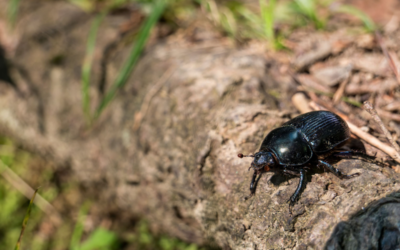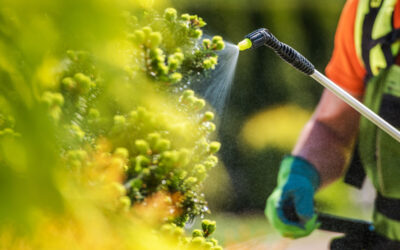Yellowing Leaves? Don’t Let Iron Chlorosis Steal the Show from Your Trees
Here in the Mile High City, our beautiful Denver metro area boasts stunning scenery, and a big part of that charm comes from our vibrant trees. But sometimes, even the most majestic trees can face challenges. One common issue for Denver trees is iron chlorosis, a condition that can leave your once-lush foliage looking sickly and yellow.
Iron chlorosis is the yellowing of the leaf tissue caused by an iron deficiency. In most cases, the veins in the leaf remain green. In more severe cases, the whole leaf will turn yellow. As the summer heats up, the leaves will scorch and turn brown. Iron chlorosis is very common in Autumn Blaze Maples and Red Oaks in the Denver area, but there are things you can do to treat it!
What is Iron Chlorosis?
Iron chlorosis is a nutritional deficiency that affects a tree’s ability to uptake iron from the soil. Iron is essential for chlorophyll production, the pigment that gives leaves their green color. When iron is deficient, chlorophyll production slows, and leaves begin to turn yellow – a condition known as interveinal chlorosis because the veins often remain green.
Causes of Iron Chlorosis
Many factors contribute to an iron deficiency in trees. Colorado soils have a high PH (Alkaline) and contain free lime. The alkaline soils cause the iron to form an insoluble compound that tree roots cannot absorb. Free lime acts as a PH buffer and makes it very difficult to lower the soil‘s PH.
Another factor contributing to iron chlorosis is the presence of a restricted root system, which could be caused by soil compaction, girdling roots or a confined growing space.
Why is it Prevalent in Denver?
Several factors contribute to the prevalence of iron chlorosis in the Denver metro area:
- High pH Levels: Our soil tends to be naturally alkaline, which can limit iron availability for plant roots.
- Calcareous Soils: Many Denver-area soils contain high levels of calcium carbonate (lime), which further reduces iron solubility.
- Bicarbonate Ions: These ions, also present in our soil, can bind with iron, making it even more difficult for trees to absorb it.
Commonly Affected Trees:
Some tree species are more susceptible to iron chlorosis than others. Here are a few commonly affected trees in Denver:
- Silver Maple (Acer saccharinum)
- Red Maple (Acer rubrum)
- Pin Oak (Quercus palustris)
- Honey Locust (Gleditsia triacanthos)
Signs and Symptoms:
- Interveinal chlorosis: Yellowing of leaf tissue between the veins, while the veins themselves remain green.
- Stunted growth: Iron deficiency can hinder overall tree growth and development.
- Premature leaf drop: In severe cases, leaves may turn yellow and fall prematurely.
Treatments for Iron Chlorosis
Donovan Arborists applies a macro-injection process to treat iron chlorosis in maple and oak trees. We inject this treatment directly into the xylem tissue where the tree can uptake the material readily. With maple trees, we use a combination of iron and manganese to correct iron chlorosis, while for oaks we use only iron.
We also use a product called VerDur®, an excellent choice as one treatment can last up to 3 years, which means less drilling into the tree and, therefore, less money out of your pocket. You can read more about VerDur® to learn its full benefits.
Another practice we follow is the application of a low rate of Cambistat®, a growth regulator product that promotes tree root development. This product has shown to be effective on trees that are only mildly affected by an iron deficiency. Using Cambistat® in combination with the macro-injection process, we have seen really good results.
Cultural Practices to Help With Iron Chlorosis
Planting a tree species less susceptible to iron chlorosis is the best prevention method. If your tree is on the smaller side, consider removing and replacing it with a species less prone to iron deficiency. Doing so will save you money in the long run. There are a lot of quality tree species requiring far less maintenance.
Adding small amounts of organic matter to your tree’s root zone can help improve the stability of its soil. Organic matter improves water permeability, feeds micro-organisms and helps correct soil compaction. It takes many years to see even a slight improvement but the benefits are worth the effort. We recommend adding about ¼ inch of Peat Moss over the root zone of the tree in the spring and fall. Over time, this will greatly improve the soil for your trees.
The Importance of Professional Arborist Care
While there are some at-home remedies for iron chlorosis, professional arborist care offers several benefits:
- Accurate Diagnosis: Our certified arborists can accurately diagnose the cause of your tree’s yellowing leaves, ensuring the right treatment is applied.
- Targeted Treatment: We will recommend the most effective treatment method based on the severity of the deficiency and the specific needs of your tree.
- Safe Application: Iron treatments, especially injections, should be done by qualified professionals to avoid harming your trees.
Donovan Arborists: Keeping Denver’s Trees Green
At Donovan Arborists, we are passionate about protecting the health and beauty of Denver’s urban forest. If you’re noticing yellowing leaves on your trees, contact us today at (303) 623-8733 for a consultation or use our Free Estimate form. We’ll diagnose the problem, recommend the most suitable treatment plan, and help your trees regain their vibrant green glory!
If you are struggling with iron chlorosis in your trees, we would love to talk with you and find a solution. We are locally-owned and operated in Denver, CO and service the greater metro area and surrounding cities. Dedicated to protecting your investments and helping your trees thrive in the most environmentally-friendly way possible, we are ISA-Certified with over 20 years of experience in the Front Range.




